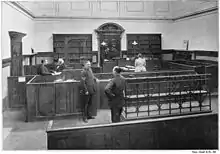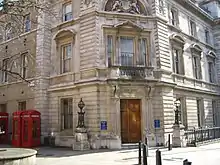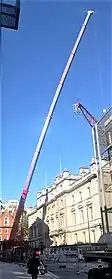Bow Street Magistrates' Court
Bow Street Magistrates' Court became one of the most famous magistrates' court in England. Over its 266-year existence it occupied various buildings on Bow Street in Central London, immediately north-east of Covent Garden. It closed in 2006 and its work moved to a set of four magistrates' courts: Westminster, Camberwell Green, Highbury Corner and the City of Westminster Magistrates' Court. The senior magistrate at Bow Street until 2000 was the Chief Metropolitan Stipendiary Magistrate.

The building, which is grade II listed,[1] is now a hotel and police museum.[2]
History

The first court at Bow Street was established in 1740,[3] when Colonel Sir Thomas de Veil, a Westminster justice, sat as a magistrate in his home at number 4. De Veil was succeeded by novelist and playwright Henry Fielding in 1747. He was appointed a magistrate for the City of Westminster in 1748, at a time when the problem of gin consumption and resultant crime was at its height. There were eight licensed premises in the street and Fielding reported that every fourth house in Covent Garden was a gin shop. In 1749, in response to calls to find an effective means to tackle increasing crime and disorder, Fielding brought together eight reliable constables, known as "Mr Fielding's People",[3] who soon gained a reputation for honesty and efficiency in their pursuit of criminals. The constables came to be known as the Bow Street Runners. Fielding's blind half-brother, Sir John Fielding (known as the "Blind Beak of Bow Street"), succeeded his brother as magistrate in 1754 and refined the patrol into the first truly effective police force for the capital.[4] The early 19th century saw a dramatic increase in number and scope of the police based at Bow Street with the 1805 formation of the Bow Street Horse Patrole, which covered to the edge of London and was the first uniformed police unit in Britain, and in 1821 the Dismounted Horse Patrole which covered suburban areas.
When the Metropolitan Police Service was established in 1829, a station house was soon sited at numbers 25 and 27.
In 1876 the Duke of Bedford let a site on the eastern side of Bow Street to the Commissioners of HM Works and Public Buildings for a new magistrates' court and the police station, at an annual rent of £100. Work on the current building to a design by the Office of Works' surveyor Sir John Taylor began in 1878 and was completed in 1881—the date 1879 in the stonework above the door of the present building is when it had been hoped that work would finish.[4][5] Historic England's listing entry describes the architectural style as "dignified, eclectic Graeco-Roman with some slightly Vanbrughian details, rather in the Pennethorne manner."[1]
In 1878 gazetteer Walter Thornbury published that the establishment, still called generally a Magistrates' House, consisted of "three magistrates, each attending two days in a week".[6] He added:
The chief magistrate has a large addition to his salary, in lieu of the fees taken at the office, which were formerly appropriated to his emolument, but are now carried to the public account. He also has £500 a year (equivalent to £50,075 in 2021) for the superintendence of the horse patrol. All the magistrates belonging to this office are in the Commission of the Peace for the Counties of Middlesex, Surrey, Kent, and Essex.[6]
In its later years, the court housed the office of the Senior District Judge (Magistrates' Courts), who heard high-profile matters, such as extradition cases or those involving eminent public figures.
Closure and redevelopment


The listed status of the building, containing both the court and the police station, meant that it was not economic to update it to modern standards.[7] It was accordingly considered for closure, enabling better use of a building that faces the front of the Royal Opera House.
The police station closed in 1992,[8] and in 2004 the court was put up for sale by its joint owners, the Greater London Magistrates' Courts Authority and the Metropolitan Police Authority. In July 2005 the site was bought by property developer Gerry Barrett to convert into a boutique hotel,[4] and the court closed on 14 July 2006. The final case was that of Jason John Handy, a 33-year-old alcoholic-vagrant who was accused of breaching his anti-social behaviour order. Other cases on the last day included beggars, shoplifters, illegal minicab drivers and a terrorist hearing—the first of its kind—in which a terror suspect was accused of breaching his control order. The final day was heavily attended by members of the press.[9] The court's remaining cases moved to Horseferry Road Magistrates' Court[10] which itself closed in 2011, when its work moved to the old Marylebone Court House and renamed Westminster Magistrates' Court.
In 2008 the Bow Street site was sold to Austrian developers who obtained planning permission for a hotel and police museum, while maintaining the facade of the old court building.[11][12][13] In October 2016 the site was sold on again, to the UK arm of Qatari investment firm BTC, who used the existing planning permission.[14] A 91-room hotel, run by the New York based NoMad chain, opened in May 2021, as did a public restaurant and a museum of local police history.[15][16][2]
Famous defendants
Many famous accused people have passed through Bow Street, often before committal for trial at the Central Criminal Court, Old Bailey or at other Crown Court centres, or when being held on extradition or terrorism charges. These include:
See also
References
- "Bow Street Magistrates' Court and Police Station listing". Historic England. 30 July 2001. Retrieved 14 June 2021.
- O’Flaherty, Mark (28 May 2021). "London's most famous courtroom is now the capital's hottest hotel". The Daily Telegraph. Retrieved 13 June 2021.
- White, Jerry (2007). London in the 19th Century. Vintage. p. 383.
- "Bow Street hits the end of the road". The Times. 31 July 2005.
- "Judge laments Bow Street closure". BBC News. 11 July 2006.
- Thornbury, Walter (1878). "Covent Garden: Part 3 of 3". Old and New London: Volume 3. Institute of Historical Research. Retrieved 31 October 2014.
- Weinreb, Ben; Hibbert, Christopher; Keay, Julia; Keay, John (2008). The London Encyclopedia. Pan MacMillan. p. 86. ISBN 978-1-4050-4924-5.
- "London's Bow Street Police Station to be turned into museum". BBC News. 18 December 2020. Retrieved 14 June 2021.
- Campbell, Duncan (15 July 2006). "Infamous Bow Street bows out after 271 years". The Guardian. Retrieved 15 June 2021.
- "Bow Street bows out". BBC News. 12 July 2006.
- RISE Management Consulting news (2021). "Appointment of construction manager for conversion of Bow Street Magistrates Court into luxury Boutique Hotel". Archived from the original on 6 May 2015. Retrieved 5 May 2015. (Access date 13 June 2021)
- "Neri & Hu to redevelop Bow Street Magistrates Court in Covent Garden, London". World Architecture News. 3 June 2011. Retrieved 2 July 2018. Neri & Hu architects are Lyndon Neri and Rossana Hu.
- "Neri & Hu - Bow Street Police Museum and Hotel".
- Curry, Rhiannon (31 October 2016). "Bow Street Magistrates Court snapped up by Qatari investor for luxury hotel". The Daily Telegraph. Retrieved 2 July 2018.
- "Forbes, 15 January 2019, New London Luxury Hotels To Check Into In 2019". Forbes. Retrieved 20 March 2019.
- "NoMad London to open in December". 8 July 2020. Retrieved 13 August 2020.